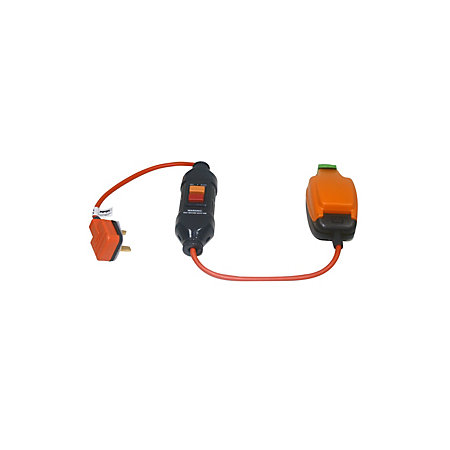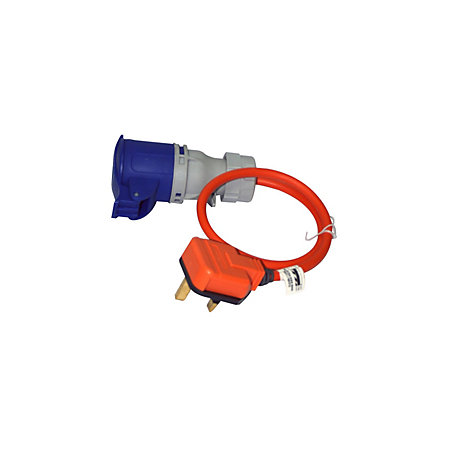For top-up when staying with friends.
Only done this once, my host had a long extension lead, we unwound it, trailed it down his drive, and put the UMC 13 AMP plug / extension socket under the car to "keep it dry" That also reduces the amount of UMC "extension" available of course.
That also reduces the amount of UMC "extension" available of course.
So I'm thinking I should carry something with me instead.
Seems I could get a formed extension lead, either 1.5mm cable up to 14M (which weighs 2.18KG)
![14m-single-socket-heavy-duty-13amp-black-extension-lead-10271-p[ekm]333x249[ekm].jpg](http://www.industrialextensionleads.co.uk/ekmps/shops/bazzer1/images/14m-single-socket-heavy-duty-13amp-black-extension-lead-10271-p[ekm]333x249[ekm].jpg)
14m single socket heavy duty 13amp black extension lead
or for something longer 2.5mm cable. Shortest on that site is 25M which is maybe longer (more unweidy? 5.2KG) than I need, and it has a double socket which is more of a rain-risk.
![25m-double-socket-heavy-duty-13amp-2.5mm-cable-extension-lead-10587-p[ekm]333x249[ekm].jpg](http://www.industrialextensionleads.co.uk/ekmps/shops/bazzer1/images/25m-double-socket-heavy-duty-13amp-2.5mm-cable-extension-lead-10587-p[ekm]333x249[ekm].jpg)
25m double socket heavy duty 13amp 2.5mm cable extension lead
I could also get a DRiBOX, but surely that's just one more thing to cart about?
![dribox-285-meduim-perfect-for-our-2-way-outdoor-extension-leads-10949-p[ekm]333x249[ekm].jpg](http://www.industrialextensionleads.co.uk/ekmps/shops/bazzer1/images/dribox-285-meduim-perfect-for-our-2-way-outdoor-extension-leads-10949-p[ekm]333x249[ekm].jpg)
![dribox-285-meduim-perfect-for-our-2-way-outdoor-extension-leads-[3]-10949-p.jpg](http://www.industrialextensionleads.co.uk/ekmps/shops/bazzer1/images/dribox-285-meduim-perfect-for-our-2-way-outdoor-extension-leads-[3]-10949-p.jpg)
Would a 13a plug to commando socket be better? Strikes me as being better outside. Presumably my UMC would plug into that? Although no alternative use around the garden.
![14m-230v-13a-plug-top-to-commando-socket-adaptor-10492-p[ekm]333x249[ekm].jpg](http://www.industrialextensionleads.co.uk/ekmps/shops/bazzer1/images/14m-230v-13a-plug-top-to-commando-socket-adaptor-10492-p[ekm]333x249[ekm].jpg)
14m 230v 13a plug-top to commando socket adaptor
Can I (should I??) make my own? I'm thinking 2.5mm but shorter than 25M
I already have a fairly beefy reel extension (used for a commercial-grade pressure washer, which tripped our "ordinary" extension reel). Maybe I could just take that with me on the few occasions we want to adhoc-charge? Its labelled as "50M heavy duty cable extension reel 13amp 3G 2.5mm welding 7kg".

Anything in particular I should think about when choosing a socket when I arrive? (assuming there is a choice!) Any way to choose circuits more likely to be more comfortable with sustained load?
My understanding is that I'm going to get 10A / 2.3kW and around 5 MPH. Naive question I expect: why can't I get 3kW?, given that's my understanding of what a 3-bar-fire will use
I didn't buy a Type-2 cable when i bought the car, for "public charging" I think I ought to get one of those too.
Open to any other suggestions too. Thanks.
Only done this once, my host had a long extension lead, we unwound it, trailed it down his drive, and put the UMC 13 AMP plug / extension socket under the car to "keep it dry"
So I'm thinking I should carry something with me instead.
Seems I could get a formed extension lead, either 1.5mm cable up to 14M (which weighs 2.18KG)
![14m-single-socket-heavy-duty-13amp-black-extension-lead-10271-p[ekm]333x249[ekm].jpg](http://www.industrialextensionleads.co.uk/ekmps/shops/bazzer1/images/14m-single-socket-heavy-duty-13amp-black-extension-lead-10271-p[ekm]333x249[ekm].jpg)
14m single socket heavy duty 13amp black extension lead
or for something longer 2.5mm cable. Shortest on that site is 25M which is maybe longer (more unweidy? 5.2KG) than I need, and it has a double socket which is more of a rain-risk.
![25m-double-socket-heavy-duty-13amp-2.5mm-cable-extension-lead-10587-p[ekm]333x249[ekm].jpg](http://www.industrialextensionleads.co.uk/ekmps/shops/bazzer1/images/25m-double-socket-heavy-duty-13amp-2.5mm-cable-extension-lead-10587-p[ekm]333x249[ekm].jpg)
25m double socket heavy duty 13amp 2.5mm cable extension lead
I could also get a DRiBOX, but surely that's just one more thing to cart about?
![dribox-285-meduim-perfect-for-our-2-way-outdoor-extension-leads-10949-p[ekm]333x249[ekm].jpg](http://www.industrialextensionleads.co.uk/ekmps/shops/bazzer1/images/dribox-285-meduim-perfect-for-our-2-way-outdoor-extension-leads-10949-p[ekm]333x249[ekm].jpg)
![dribox-285-meduim-perfect-for-our-2-way-outdoor-extension-leads-[3]-10949-p.jpg](http://www.industrialextensionleads.co.uk/ekmps/shops/bazzer1/images/dribox-285-meduim-perfect-for-our-2-way-outdoor-extension-leads-[3]-10949-p.jpg)
Would a 13a plug to commando socket be better? Strikes me as being better outside. Presumably my UMC would plug into that? Although no alternative use around the garden.
![14m-230v-13a-plug-top-to-commando-socket-adaptor-10492-p[ekm]333x249[ekm].jpg](http://www.industrialextensionleads.co.uk/ekmps/shops/bazzer1/images/14m-230v-13a-plug-top-to-commando-socket-adaptor-10492-p[ekm]333x249[ekm].jpg)
14m 230v 13a plug-top to commando socket adaptor
Can I (should I??) make my own? I'm thinking 2.5mm but shorter than 25M
I already have a fairly beefy reel extension (used for a commercial-grade pressure washer, which tripped our "ordinary" extension reel). Maybe I could just take that with me on the few occasions we want to adhoc-charge? Its labelled as "50M heavy duty cable extension reel 13amp 3G 2.5mm welding 7kg".

Anything in particular I should think about when choosing a socket when I arrive? (assuming there is a choice!) Any way to choose circuits more likely to be more comfortable with sustained load?
My understanding is that I'm going to get 10A / 2.3kW and around 5 MPH. Naive question I expect: why can't I get 3kW?, given that's my understanding of what a 3-bar-fire will use
I didn't buy a Type-2 cable when i bought the car, for "public charging" I think I ought to get one of those too.
Open to any other suggestions too. Thanks.





![14m-rcd-protected-single-socket-13amp-heavy-duty-extension-lead-10291-p[ekm]333x249[ekm].jpg](http://www.industrialextensionleads.co.uk/ekmps/shops/bazzer1/images/14m-rcd-protected-single-socket-13amp-heavy-duty-extension-lead-10291-p[ekm]333x249[ekm].jpg)
![1m-16amp-extension-lead-with-inline-16a-rated-rcd--11180-p[ekm]333x187[ekm].jpg](http://www.industrialextensionleads.co.uk/ekmps/shops/bazzer1/images/1m-16amp-extension-lead-with-inline-16a-rated-rcd--11180-p[ekm]333x187[ekm].jpg)

